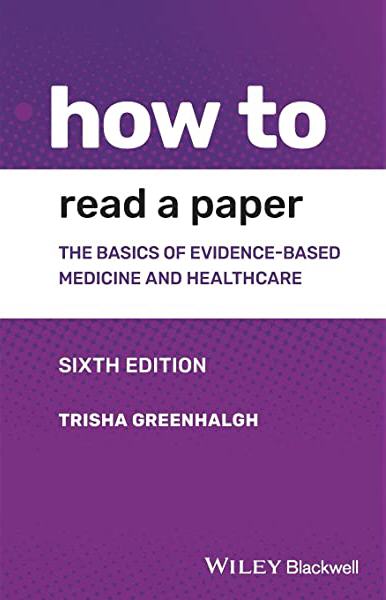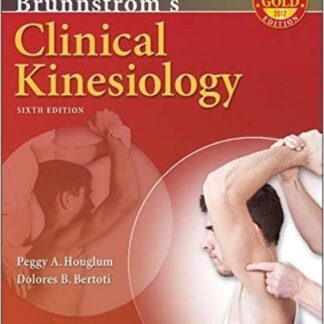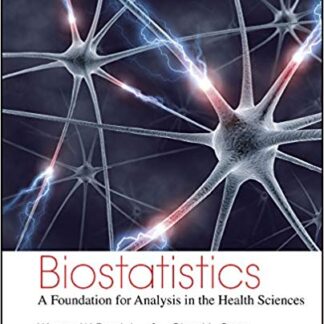Description
How to Read a Paper: The Basics of Evidence-based Medicine and Healthcare 6th Edition, ISBN-13: 978-1119484745
[PDF eBook eTextbook]
- Publisher: Wiley-Blackwell; 6th edition (May 6, 2019)
- Language: English
- 288 pages
- ISBN-10: 111948474X
- ISBN-13: 978-1119484745
The bestselling guide to evidence-based medicine and healthcare.
Required reading in many medical and healthcare institutions, How to Read a Paper is a clear and wide-ranging introduction to evidence-based medicine and healthcare, helping readers to understand its central principles, critically evaluate published data, and implement the results in practical settings. Author Trisha Greenhalgh guides readers through each fundamental step of inquiry, from searching the literature to assessing methodological quality and appraising statistics.
How to Read a Paper addresses the common criticisms of evidence-based healthcare, dispelling many of its myths and misconceptions, while providing a pragmatic framework for testing the validity of healthcare literature. Now in its sixth edition, this informative text includes new and expanded discussions of study bias, political interference in published reports, medical statistics, big data and more.
- Offers user-friendly guidance on evidence-based healthcare that is applicable to both experienced and novice readers
- Authored by an internationally recognised practitioner and researcher in evidence-based healthcare and primary care
- Includes updated references, additional figures, improved checklists and more
How to Read a Paper is an ideal resource for healthcare students, practitioners and anyone seeking an accessible introduction to evidence-based healthcare.
TRISHA GREENHALGH, OBE, FMedSci is Professor of Primary Care Health Sciences, Nuffield Department of Primary Care Health Sciences, Medical Sciences Division, University of Oxford, UK.
Table of Contents:
Foreword to the first edition by Professor Sir David Weatherall xii
Preface to the sixth edition xiv
Preface to the first edition xvi
Acknowledgements xviii
Chapter 1 Why read papers at all? 1
Does ‘evidence‐based medicine’ simply mean ‘reading papers in medical journals’? 1
Why do people sometimes groan when you mention evidence‐based healthcare? 4
Before you start: formulate the problem 11
Exercises based on this chapter 13
References 14
Chapter 2 Searching the literature 16
What are you looking for? 17
Levels upon levels of evidence 18
Synthesised sources: systems, summaries and syntheses 19
Pre‐appraised sources: synopses of systematic reviews and primary studies 22
Specialised resources 23
Primary studies – tackling the jungle 23
One‐stop shopping: federated search engines 25
Asking for help and asking around 26
Online tutorials for effective searching 26
Exercises based on this chapter 27
References 27
Chapter 3 Getting your bearings: what is this paper about? 29
The science of ‘trashing’ papers 29
Three preliminary questions to get your bearings 31
Randomised controlled trials 35
Cohort studies 38
Case–control studies 40
Cross‐sectional surveys 41
Case reports 41
The traditional hierarchy of evidence 42
Exercises based on this chapter 43
References 43
Chapter 4 Assessing methodological quality 45
Was the study original? 45
Whom is the study about? 46
Was the design of the study sensible? 47
Was bias avoided or minimised? 49
Was assessment ‘blind’? 53
Were preliminary statistical questions addressed? 54
A note on ethical considerations 57
Summing up 58
Exercises based on this chapter 59
References 60
Chapter 5 Statistics for the non‐statistician 62
How can non‐statisticians evaluate statistical tests? 62
Have the authors set the scene correctly? 64
Paired data, tails and outliers 69
Correlation, regression and causation 71
Probability and confidence 73
The bottom line 75
Summary 77
Exercises based on this chapter 77
References 78
Chapter 6 Papers that report trials of drug treatments and other simple interventions 79
‘Evidence’ and marketing 79
Making decisions about therapy 82
Surrogate endpoints 82
What information to expect in a paper describing a randomised controlled trial: the CONSORT statement 86
Getting worthwhile evidence from pharmaceutical representatives 86
Exercises based on this chapter 89
References 89
Chapter 7 Papers that report trials of complex interventions 92
Complex interventions 92
Ten questions to ask about a paper describing a complex intervention 94
Exercises based on this chapter 99
References 100
Chapter 8 Papers that report diagnostic or screening tests 101
Ten men in the dock 101
Validating diagnostic tests against a gold standard 102
Ten questions to ask about a paper that claims to validate a diagnostic or screening test 107
Likelihood ratios 111
Clinical prediction rules 113
Exercises based on this chapter 114
References 115
Chapter 9 Papers that summarise other papers (systematic reviews and meta‐analyses) 117
When is a review systematic? 117
Evaluating systematic reviews 120
Meta‐analysis for the non‐statistician 125
Explaining heterogeneity 130
New approaches to systematic review 132
Exercises based on this chapter 133
References 133
Chapter 10 Papers that tell you what to do (guidelines) 137
The great guidelines debate 137
Ten questions to ask about a clinical guideline 141
Exercises based on this chapter 147
References 148
Chapter 11 Papers that tell you what things cost (economic analyses) 150
What is economic analysis? 150
Measuring the costs and benefits of health interventions 152
A note on ‘Choosing Wisely’ 157
Ten questions to ask about an economic analysis 157
Conclusions 162
Exercises based on this chapter 162
References 162
Chapter 12 Papers that go beyond numbers (qualitative research) 165
What is qualitative research? 165
Ten questions to ask about a qualitative research paper 169
Conclusions 176
Exercises based on this chapter 176
References 177
Chapter 13 Papers that report questionnaire research 179
The rise and rise of questionnaire research 179
Ten questions to ask about a paper describing a questionnaire study 180
Conclusions 188
Exercises based on this chapter 189
References 189
Chapter 14 Papers that report quality improvement case studies 191
What are quality improvement studies, and how should we research them? 191
Ten questions to ask about a paper describing a quality improvement initiative 193
Conclusions 200
Exercises based on this chapter 200
References 201
Chapter 15 Papers that describe genetic association studies 203
The three eras of human genetic studies (so far) 203
What is a genome‐wide association study (GWAS)? 204
Clinical applications of GWAS 207
Direct‐to‐consumer genetic testing 209
Mendelian randomisation studies 210
Epigenetics – a space to watch 211
Ten questions to ask about a genetic association study 212
Conclusions 216
Exercises based on this chapter 216
References 216
Chapter 16 Applying evidence with patients 219
The patient perspective 219
Patient‐reported outcome measures (PROMs) 221
Shared decision‐making 222
Option grids 223
N of 1 trials and other individualised approaches 227
Exercises based on this chapter 228
References 229
Chapter 17 Criticisms of evidence‐based healthcare 232
What’s wrong with EBHC when it’s done badly? 232
What’s wrong with EBHC when it’s done well? 235
Why is ‘evidence‐based policymaking’ so hard to achieve? 238
Exercises based on this chapter 239
References 240
Appendix 1 Checklists for finding, appraising and implementing evidence 242
Appendix 2 Assessing the effects of an intervention 252
Index 253
What makes us different?
• Instant Download
• Always Competitive Pricing
• 100% Privacy
• FREE Sample Available
• 24-7 LIVE Customer Support




